Innovation Management
VerifiedAdded on 2023/06/07
|20
|5398
|308
AI Summary
This article discusses innovation management and how to improve innovative capabilities. It includes an interview with Alastair Coleman, founder of Nothing but Web, and insights into innovation management theories and models. The article also includes a reflection on personal innovation capability and planning for improvement.
Contribute Materials
Your contribution can guide someone’s learning journey. Share your
documents today.

Running head: INNOVATION MANAGEMENT
Innovation management
Name of the student:
Name of the university:
Author note:
Innovation management
Name of the student:
Name of the university:
Author note:
Secure Best Marks with AI Grader
Need help grading? Try our AI Grader for instant feedback on your assignments.
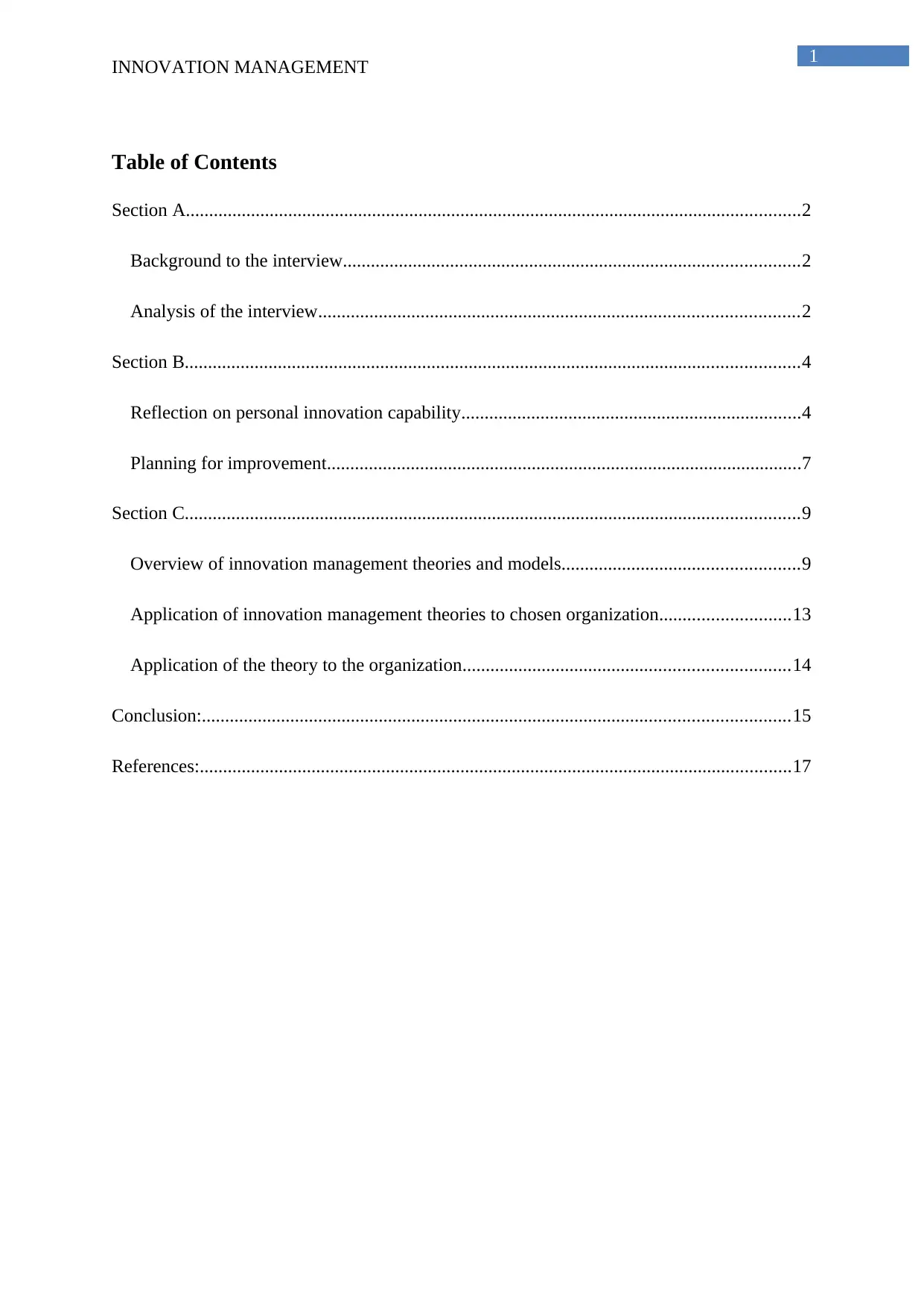
1
INNOVATION MANAGEMENT
Table of Contents
Section A....................................................................................................................................2
Background to the interview..................................................................................................2
Analysis of the interview.......................................................................................................2
Section B....................................................................................................................................4
Reflection on personal innovation capability.........................................................................4
Planning for improvement......................................................................................................7
Section C....................................................................................................................................9
Overview of innovation management theories and models...................................................9
Application of innovation management theories to chosen organization............................13
Application of the theory to the organization......................................................................14
Conclusion:..............................................................................................................................15
References:...............................................................................................................................17
INNOVATION MANAGEMENT
Table of Contents
Section A....................................................................................................................................2
Background to the interview..................................................................................................2
Analysis of the interview.......................................................................................................2
Section B....................................................................................................................................4
Reflection on personal innovation capability.........................................................................4
Planning for improvement......................................................................................................7
Section C....................................................................................................................................9
Overview of innovation management theories and models...................................................9
Application of innovation management theories to chosen organization............................13
Application of the theory to the organization......................................................................14
Conclusion:..............................................................................................................................15
References:...............................................................................................................................17
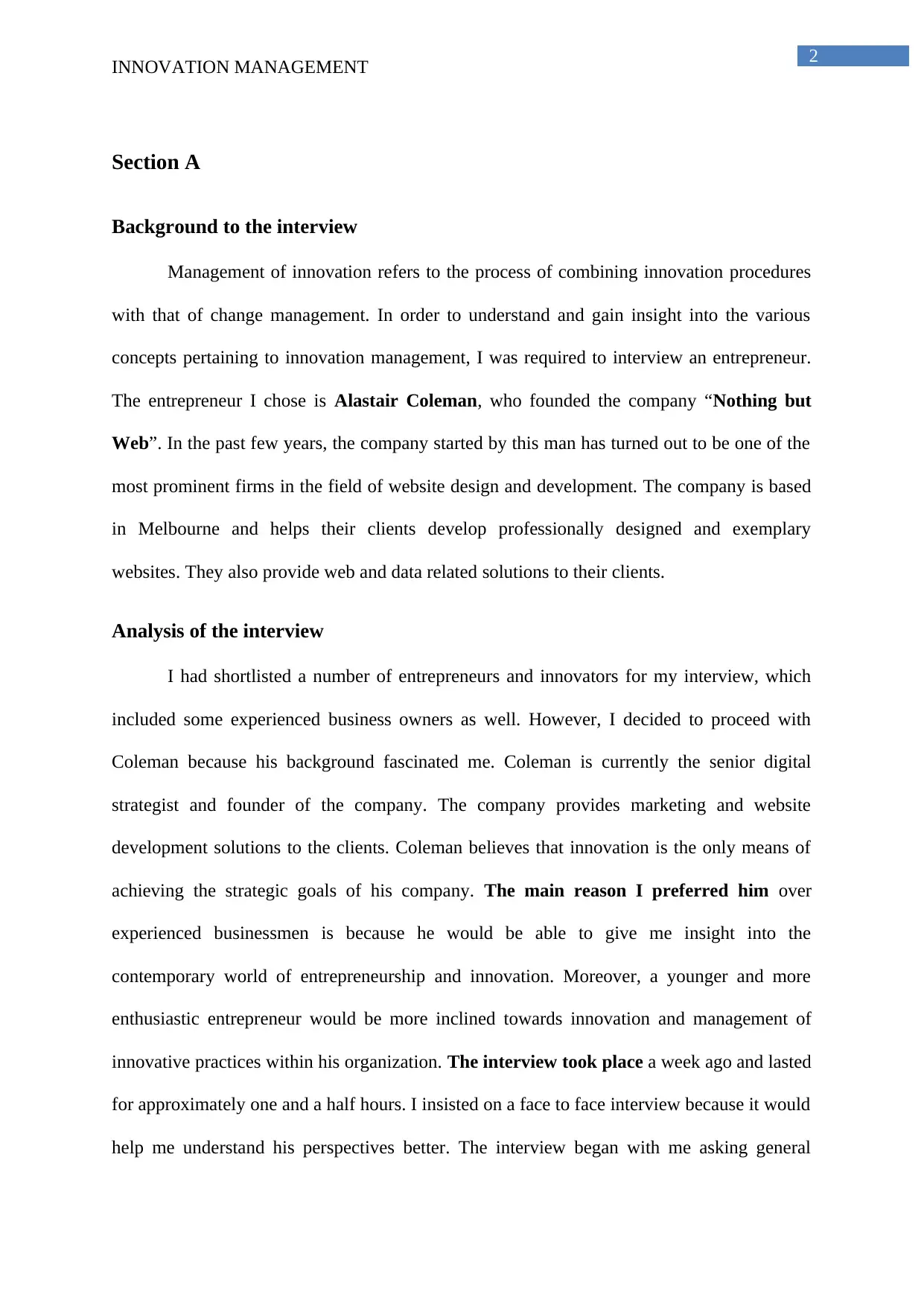
2
INNOVATION MANAGEMENT
Section A
Background to the interview
Management of innovation refers to the process of combining innovation procedures
with that of change management. In order to understand and gain insight into the various
concepts pertaining to innovation management, I was required to interview an entrepreneur.
The entrepreneur I chose is Alastair Coleman, who founded the company “Nothing but
Web”. In the past few years, the company started by this man has turned out to be one of the
most prominent firms in the field of website design and development. The company is based
in Melbourne and helps their clients develop professionally designed and exemplary
websites. They also provide web and data related solutions to their clients.
Analysis of the interview
I had shortlisted a number of entrepreneurs and innovators for my interview, which
included some experienced business owners as well. However, I decided to proceed with
Coleman because his background fascinated me. Coleman is currently the senior digital
strategist and founder of the company. The company provides marketing and website
development solutions to the clients. Coleman believes that innovation is the only means of
achieving the strategic goals of his company. The main reason I preferred him over
experienced businessmen is because he would be able to give me insight into the
contemporary world of entrepreneurship and innovation. Moreover, a younger and more
enthusiastic entrepreneur would be more inclined towards innovation and management of
innovative practices within his organization. The interview took place a week ago and lasted
for approximately one and a half hours. I insisted on a face to face interview because it would
help me understand his perspectives better. The interview began with me asking general
INNOVATION MANAGEMENT
Section A
Background to the interview
Management of innovation refers to the process of combining innovation procedures
with that of change management. In order to understand and gain insight into the various
concepts pertaining to innovation management, I was required to interview an entrepreneur.
The entrepreneur I chose is Alastair Coleman, who founded the company “Nothing but
Web”. In the past few years, the company started by this man has turned out to be one of the
most prominent firms in the field of website design and development. The company is based
in Melbourne and helps their clients develop professionally designed and exemplary
websites. They also provide web and data related solutions to their clients.
Analysis of the interview
I had shortlisted a number of entrepreneurs and innovators for my interview, which
included some experienced business owners as well. However, I decided to proceed with
Coleman because his background fascinated me. Coleman is currently the senior digital
strategist and founder of the company. The company provides marketing and website
development solutions to the clients. Coleman believes that innovation is the only means of
achieving the strategic goals of his company. The main reason I preferred him over
experienced businessmen is because he would be able to give me insight into the
contemporary world of entrepreneurship and innovation. Moreover, a younger and more
enthusiastic entrepreneur would be more inclined towards innovation and management of
innovative practices within his organization. The interview took place a week ago and lasted
for approximately one and a half hours. I insisted on a face to face interview because it would
help me understand his perspectives better. The interview began with me asking general
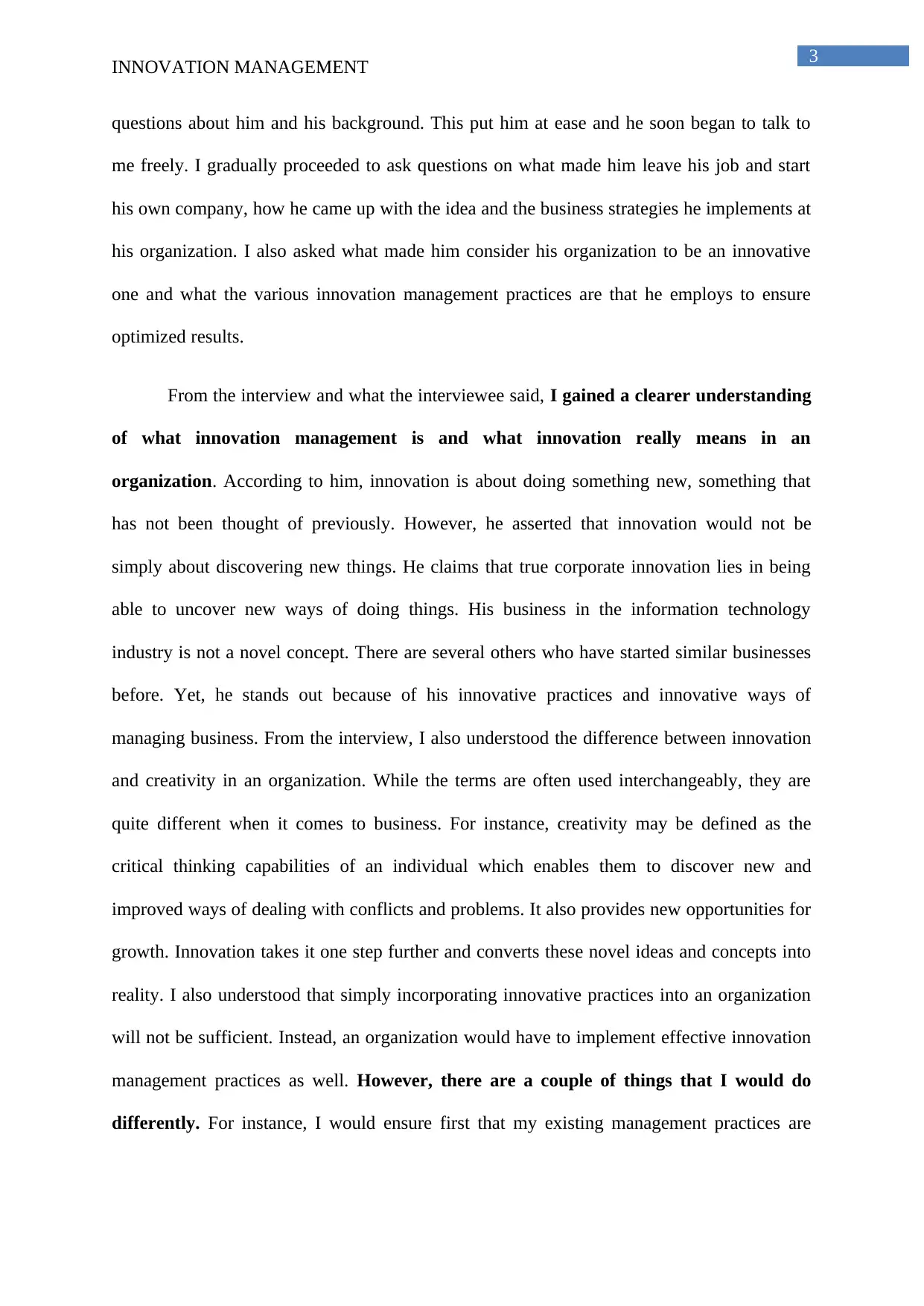
3
INNOVATION MANAGEMENT
questions about him and his background. This put him at ease and he soon began to talk to
me freely. I gradually proceeded to ask questions on what made him leave his job and start
his own company, how he came up with the idea and the business strategies he implements at
his organization. I also asked what made him consider his organization to be an innovative
one and what the various innovation management practices are that he employs to ensure
optimized results.
From the interview and what the interviewee said, I gained a clearer understanding
of what innovation management is and what innovation really means in an
organization. According to him, innovation is about doing something new, something that
has not been thought of previously. However, he asserted that innovation would not be
simply about discovering new things. He claims that true corporate innovation lies in being
able to uncover new ways of doing things. His business in the information technology
industry is not a novel concept. There are several others who have started similar businesses
before. Yet, he stands out because of his innovative practices and innovative ways of
managing business. From the interview, I also understood the difference between innovation
and creativity in an organization. While the terms are often used interchangeably, they are
quite different when it comes to business. For instance, creativity may be defined as the
critical thinking capabilities of an individual which enables them to discover new and
improved ways of dealing with conflicts and problems. It also provides new opportunities for
growth. Innovation takes it one step further and converts these novel ideas and concepts into
reality. I also understood that simply incorporating innovative practices into an organization
will not be sufficient. Instead, an organization would have to implement effective innovation
management practices as well. However, there are a couple of things that I would do
differently. For instance, I would ensure first that my existing management practices are
INNOVATION MANAGEMENT
questions about him and his background. This put him at ease and he soon began to talk to
me freely. I gradually proceeded to ask questions on what made him leave his job and start
his own company, how he came up with the idea and the business strategies he implements at
his organization. I also asked what made him consider his organization to be an innovative
one and what the various innovation management practices are that he employs to ensure
optimized results.
From the interview and what the interviewee said, I gained a clearer understanding
of what innovation management is and what innovation really means in an
organization. According to him, innovation is about doing something new, something that
has not been thought of previously. However, he asserted that innovation would not be
simply about discovering new things. He claims that true corporate innovation lies in being
able to uncover new ways of doing things. His business in the information technology
industry is not a novel concept. There are several others who have started similar businesses
before. Yet, he stands out because of his innovative practices and innovative ways of
managing business. From the interview, I also understood the difference between innovation
and creativity in an organization. While the terms are often used interchangeably, they are
quite different when it comes to business. For instance, creativity may be defined as the
critical thinking capabilities of an individual which enables them to discover new and
improved ways of dealing with conflicts and problems. It also provides new opportunities for
growth. Innovation takes it one step further and converts these novel ideas and concepts into
reality. I also understood that simply incorporating innovative practices into an organization
will not be sufficient. Instead, an organization would have to implement effective innovation
management practices as well. However, there are a couple of things that I would do
differently. For instance, I would ensure first that my existing management practices are
Secure Best Marks with AI Grader
Need help grading? Try our AI Grader for instant feedback on your assignments.
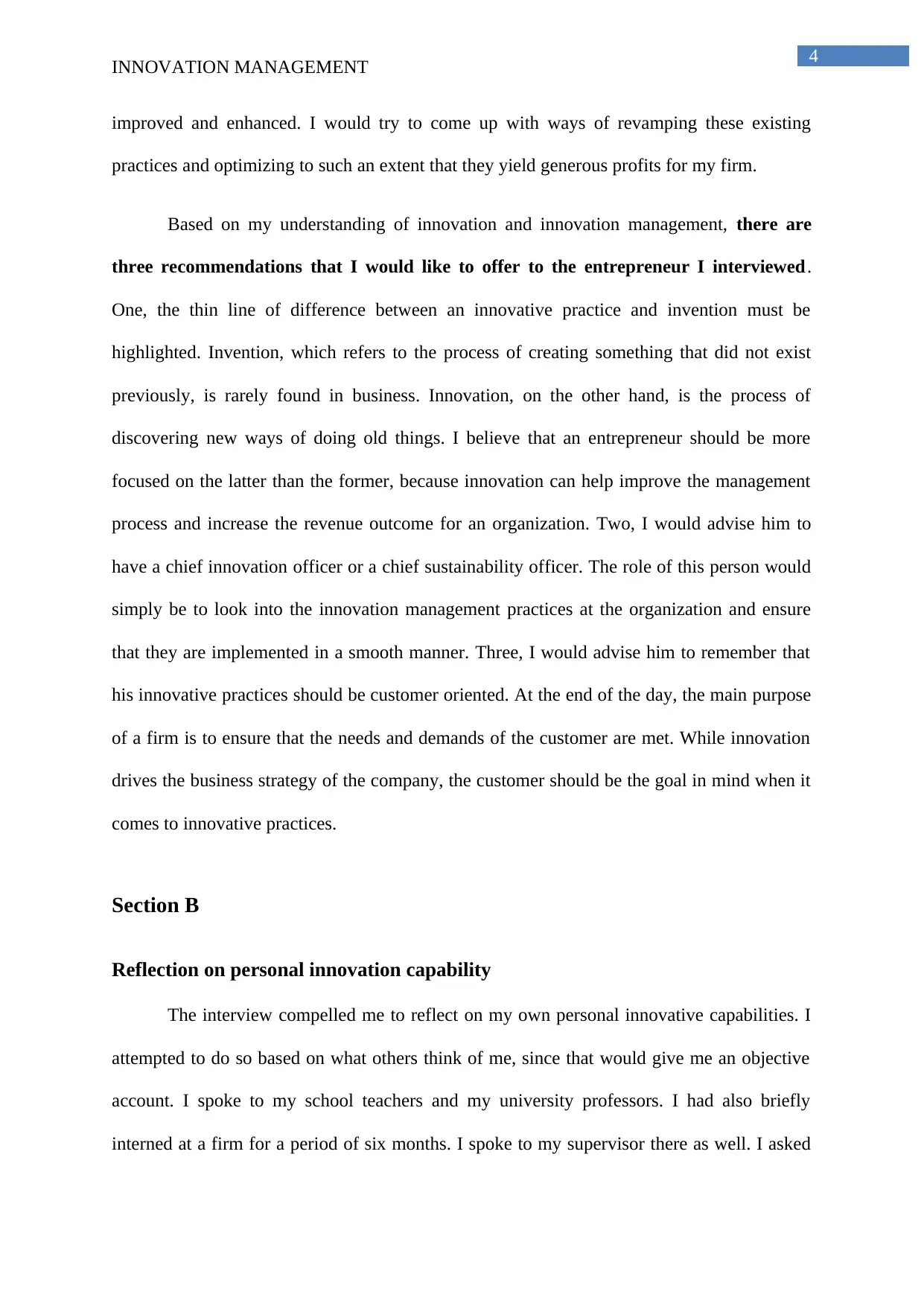
4
INNOVATION MANAGEMENT
improved and enhanced. I would try to come up with ways of revamping these existing
practices and optimizing to such an extent that they yield generous profits for my firm.
Based on my understanding of innovation and innovation management, there are
three recommendations that I would like to offer to the entrepreneur I interviewed.
One, the thin line of difference between an innovative practice and invention must be
highlighted. Invention, which refers to the process of creating something that did not exist
previously, is rarely found in business. Innovation, on the other hand, is the process of
discovering new ways of doing old things. I believe that an entrepreneur should be more
focused on the latter than the former, because innovation can help improve the management
process and increase the revenue outcome for an organization. Two, I would advise him to
have a chief innovation officer or a chief sustainability officer. The role of this person would
simply be to look into the innovation management practices at the organization and ensure
that they are implemented in a smooth manner. Three, I would advise him to remember that
his innovative practices should be customer oriented. At the end of the day, the main purpose
of a firm is to ensure that the needs and demands of the customer are met. While innovation
drives the business strategy of the company, the customer should be the goal in mind when it
comes to innovative practices.
Section B
Reflection on personal innovation capability
The interview compelled me to reflect on my own personal innovative capabilities. I
attempted to do so based on what others think of me, since that would give me an objective
account. I spoke to my school teachers and my university professors. I had also briefly
interned at a firm for a period of six months. I spoke to my supervisor there as well. I asked
INNOVATION MANAGEMENT
improved and enhanced. I would try to come up with ways of revamping these existing
practices and optimizing to such an extent that they yield generous profits for my firm.
Based on my understanding of innovation and innovation management, there are
three recommendations that I would like to offer to the entrepreneur I interviewed.
One, the thin line of difference between an innovative practice and invention must be
highlighted. Invention, which refers to the process of creating something that did not exist
previously, is rarely found in business. Innovation, on the other hand, is the process of
discovering new ways of doing old things. I believe that an entrepreneur should be more
focused on the latter than the former, because innovation can help improve the management
process and increase the revenue outcome for an organization. Two, I would advise him to
have a chief innovation officer or a chief sustainability officer. The role of this person would
simply be to look into the innovation management practices at the organization and ensure
that they are implemented in a smooth manner. Three, I would advise him to remember that
his innovative practices should be customer oriented. At the end of the day, the main purpose
of a firm is to ensure that the needs and demands of the customer are met. While innovation
drives the business strategy of the company, the customer should be the goal in mind when it
comes to innovative practices.
Section B
Reflection on personal innovation capability
The interview compelled me to reflect on my own personal innovative capabilities. I
attempted to do so based on what others think of me, since that would give me an objective
account. I spoke to my school teachers and my university professors. I had also briefly
interned at a firm for a period of six months. I spoke to my supervisor there as well. I asked
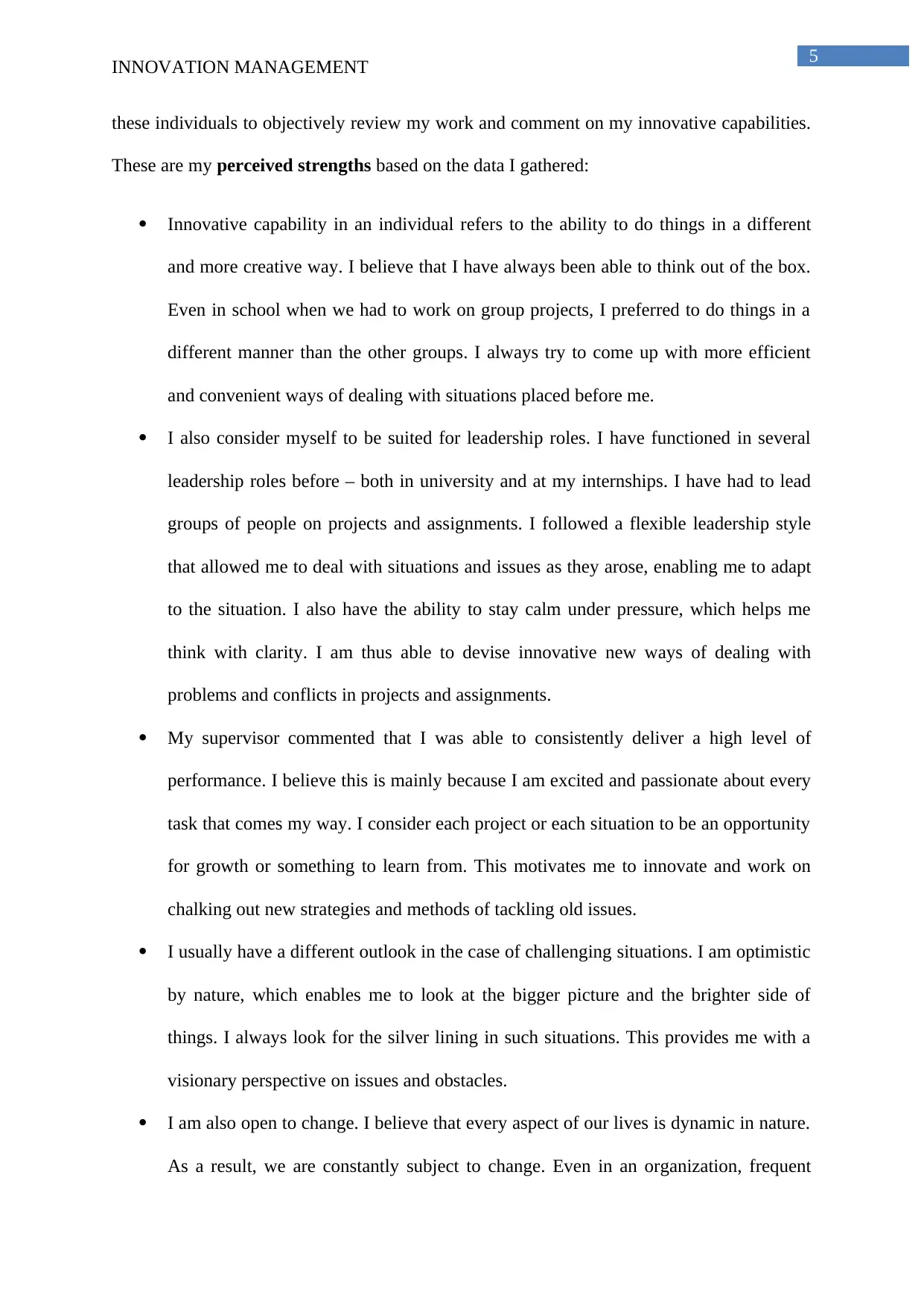
5
INNOVATION MANAGEMENT
these individuals to objectively review my work and comment on my innovative capabilities.
These are my perceived strengths based on the data I gathered:
Innovative capability in an individual refers to the ability to do things in a different
and more creative way. I believe that I have always been able to think out of the box.
Even in school when we had to work on group projects, I preferred to do things in a
different manner than the other groups. I always try to come up with more efficient
and convenient ways of dealing with situations placed before me.
I also consider myself to be suited for leadership roles. I have functioned in several
leadership roles before – both in university and at my internships. I have had to lead
groups of people on projects and assignments. I followed a flexible leadership style
that allowed me to deal with situations and issues as they arose, enabling me to adapt
to the situation. I also have the ability to stay calm under pressure, which helps me
think with clarity. I am thus able to devise innovative new ways of dealing with
problems and conflicts in projects and assignments.
My supervisor commented that I was able to consistently deliver a high level of
performance. I believe this is mainly because I am excited and passionate about every
task that comes my way. I consider each project or each situation to be an opportunity
for growth or something to learn from. This motivates me to innovate and work on
chalking out new strategies and methods of tackling old issues.
I usually have a different outlook in the case of challenging situations. I am optimistic
by nature, which enables me to look at the bigger picture and the brighter side of
things. I always look for the silver lining in such situations. This provides me with a
visionary perspective on issues and obstacles.
I am also open to change. I believe that every aspect of our lives is dynamic in nature.
As a result, we are constantly subject to change. Even in an organization, frequent
INNOVATION MANAGEMENT
these individuals to objectively review my work and comment on my innovative capabilities.
These are my perceived strengths based on the data I gathered:
Innovative capability in an individual refers to the ability to do things in a different
and more creative way. I believe that I have always been able to think out of the box.
Even in school when we had to work on group projects, I preferred to do things in a
different manner than the other groups. I always try to come up with more efficient
and convenient ways of dealing with situations placed before me.
I also consider myself to be suited for leadership roles. I have functioned in several
leadership roles before – both in university and at my internships. I have had to lead
groups of people on projects and assignments. I followed a flexible leadership style
that allowed me to deal with situations and issues as they arose, enabling me to adapt
to the situation. I also have the ability to stay calm under pressure, which helps me
think with clarity. I am thus able to devise innovative new ways of dealing with
problems and conflicts in projects and assignments.
My supervisor commented that I was able to consistently deliver a high level of
performance. I believe this is mainly because I am excited and passionate about every
task that comes my way. I consider each project or each situation to be an opportunity
for growth or something to learn from. This motivates me to innovate and work on
chalking out new strategies and methods of tackling old issues.
I usually have a different outlook in the case of challenging situations. I am optimistic
by nature, which enables me to look at the bigger picture and the brighter side of
things. I always look for the silver lining in such situations. This provides me with a
visionary perspective on issues and obstacles.
I am also open to change. I believe that every aspect of our lives is dynamic in nature.
As a result, we are constantly subject to change. Even in an organization, frequent

6
INNOVATION MANAGEMENT
changes are implemented to improve operations and optimize business processes.
Most of the people are usually resistant to any kind of change. On the other hand, I
believe that embracing change would help me progress and succeed. I generally take
proactive stances in such situations, which is usually much appreciated.
I am also very thorough when it comes to research, solutions, presentation or any such
aspects. Whenever I am assigned a task or a project, I prefer to carry out significant
research before proceeding. I like to have sufficient data and resources that would
make my work easier in the long run. My ability to focus on details helps me enhance
my innovative capabilities.
However, the data I gathered also shed light on room for improvement. Focusing on
these skills would help me develop my innovative capability for the long run.
I would have to work on my communication skills. My superiors said that although I
had some good ideas and demonstrated creative thinking, I often failed to
communicate my ideas effectively. In order to be an innovator, one needs to have
proper communication skills and persuasion power. An innovator should be able to
convince the others about the potency of his ideas in order to win them over. I would
thus have to start working on my communication and persuasion skills. This would
also enable me to inspire others and motivate them on a similar path.
I lack experience, which would have further enhanced my effectiveness and efficiency
in terms of work. I would like to gain more professional experience which requires
me to exercise my critical thinking and evaluation powers.
Another problem I encountered, according to my teachers and supervisors, was team
effort. I preferred to work alone; instead, I should be able to collaborate with other
members of the team. With more people working towards the same goal, there would
be a diversity of knowledge and greater flow of creative and innovative ideas.
INNOVATION MANAGEMENT
changes are implemented to improve operations and optimize business processes.
Most of the people are usually resistant to any kind of change. On the other hand, I
believe that embracing change would help me progress and succeed. I generally take
proactive stances in such situations, which is usually much appreciated.
I am also very thorough when it comes to research, solutions, presentation or any such
aspects. Whenever I am assigned a task or a project, I prefer to carry out significant
research before proceeding. I like to have sufficient data and resources that would
make my work easier in the long run. My ability to focus on details helps me enhance
my innovative capabilities.
However, the data I gathered also shed light on room for improvement. Focusing on
these skills would help me develop my innovative capability for the long run.
I would have to work on my communication skills. My superiors said that although I
had some good ideas and demonstrated creative thinking, I often failed to
communicate my ideas effectively. In order to be an innovator, one needs to have
proper communication skills and persuasion power. An innovator should be able to
convince the others about the potency of his ideas in order to win them over. I would
thus have to start working on my communication and persuasion skills. This would
also enable me to inspire others and motivate them on a similar path.
I lack experience, which would have further enhanced my effectiveness and efficiency
in terms of work. I would like to gain more professional experience which requires
me to exercise my critical thinking and evaluation powers.
Another problem I encountered, according to my teachers and supervisors, was team
effort. I preferred to work alone; instead, I should be able to collaborate with other
members of the team. With more people working towards the same goal, there would
be a diversity of knowledge and greater flow of creative and innovative ideas.
Paraphrase This Document
Need a fresh take? Get an instant paraphrase of this document with our AI Paraphraser
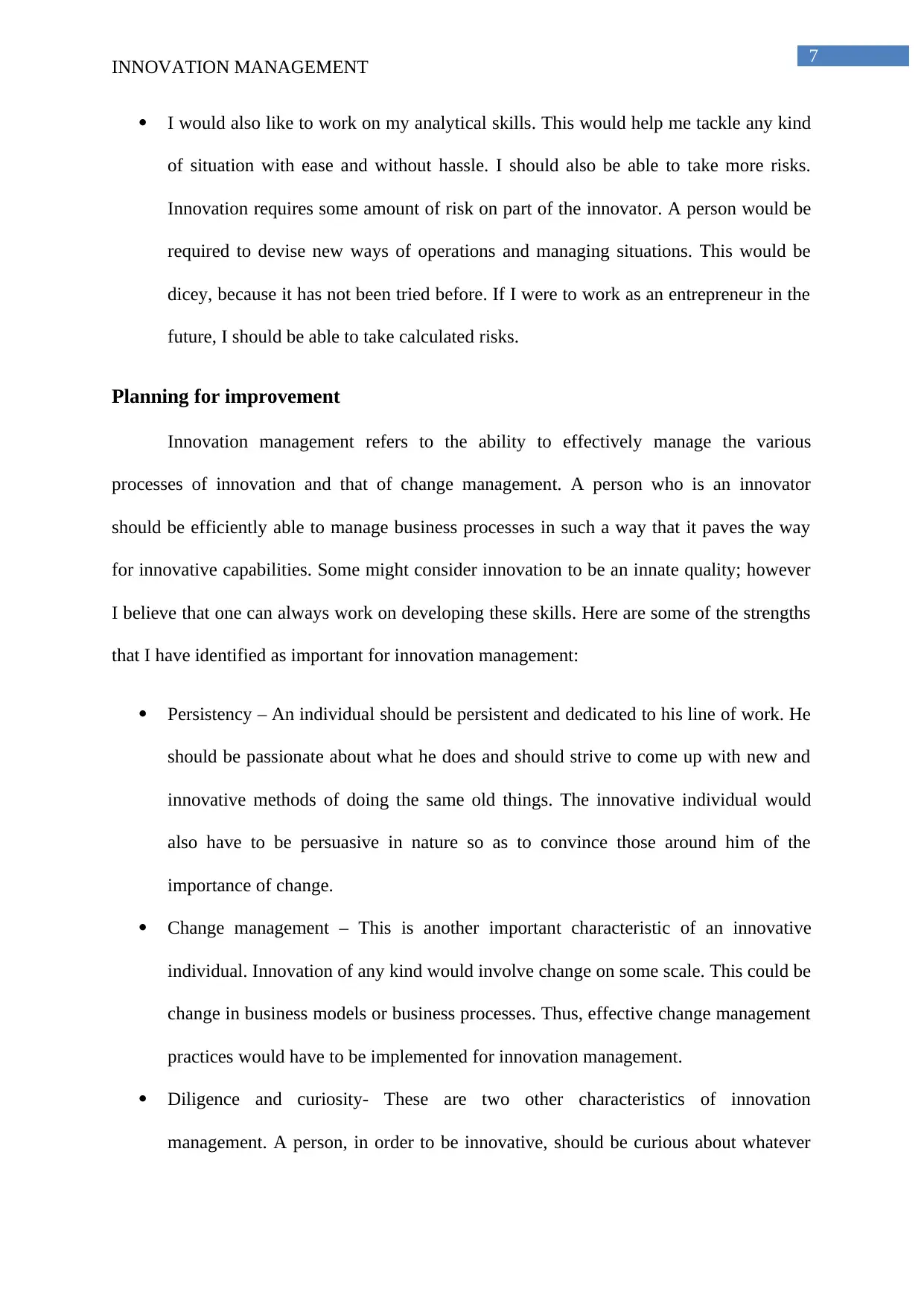
7
INNOVATION MANAGEMENT
I would also like to work on my analytical skills. This would help me tackle any kind
of situation with ease and without hassle. I should also be able to take more risks.
Innovation requires some amount of risk on part of the innovator. A person would be
required to devise new ways of operations and managing situations. This would be
dicey, because it has not been tried before. If I were to work as an entrepreneur in the
future, I should be able to take calculated risks.
Planning for improvement
Innovation management refers to the ability to effectively manage the various
processes of innovation and that of change management. A person who is an innovator
should be efficiently able to manage business processes in such a way that it paves the way
for innovative capabilities. Some might consider innovation to be an innate quality; however
I believe that one can always work on developing these skills. Here are some of the strengths
that I have identified as important for innovation management:
Persistency – An individual should be persistent and dedicated to his line of work. He
should be passionate about what he does and should strive to come up with new and
innovative methods of doing the same old things. The innovative individual would
also have to be persuasive in nature so as to convince those around him of the
importance of change.
Change management – This is another important characteristic of an innovative
individual. Innovation of any kind would involve change on some scale. This could be
change in business models or business processes. Thus, effective change management
practices would have to be implemented for innovation management.
Diligence and curiosity- These are two other characteristics of innovation
management. A person, in order to be innovative, should be curious about whatever
INNOVATION MANAGEMENT
I would also like to work on my analytical skills. This would help me tackle any kind
of situation with ease and without hassle. I should also be able to take more risks.
Innovation requires some amount of risk on part of the innovator. A person would be
required to devise new ways of operations and managing situations. This would be
dicey, because it has not been tried before. If I were to work as an entrepreneur in the
future, I should be able to take calculated risks.
Planning for improvement
Innovation management refers to the ability to effectively manage the various
processes of innovation and that of change management. A person who is an innovator
should be efficiently able to manage business processes in such a way that it paves the way
for innovative capabilities. Some might consider innovation to be an innate quality; however
I believe that one can always work on developing these skills. Here are some of the strengths
that I have identified as important for innovation management:
Persistency – An individual should be persistent and dedicated to his line of work. He
should be passionate about what he does and should strive to come up with new and
innovative methods of doing the same old things. The innovative individual would
also have to be persuasive in nature so as to convince those around him of the
importance of change.
Change management – This is another important characteristic of an innovative
individual. Innovation of any kind would involve change on some scale. This could be
change in business models or business processes. Thus, effective change management
practices would have to be implemented for innovation management.
Diligence and curiosity- These are two other characteristics of innovation
management. A person, in order to be innovative, should be curious about whatever
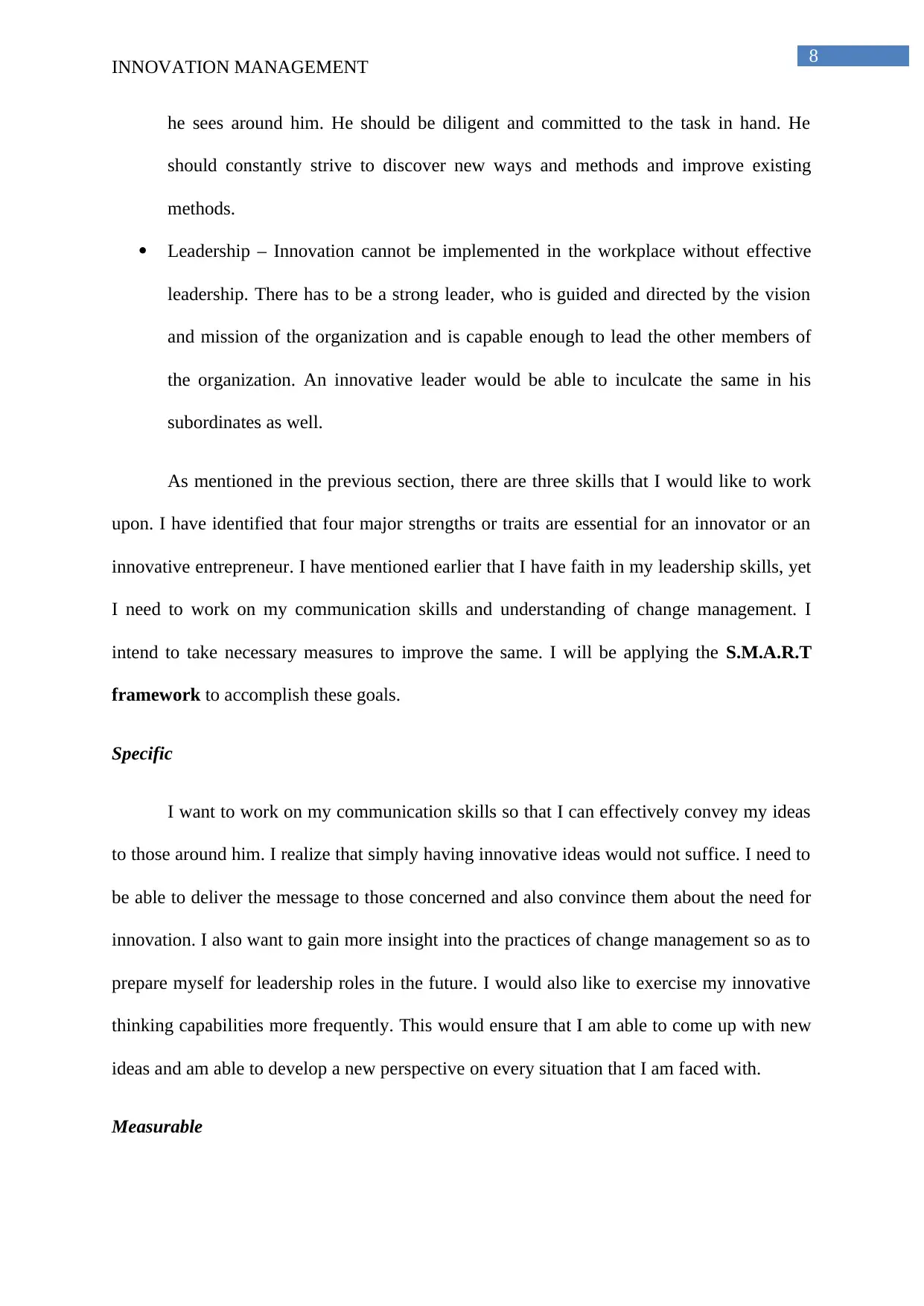
8
INNOVATION MANAGEMENT
he sees around him. He should be diligent and committed to the task in hand. He
should constantly strive to discover new ways and methods and improve existing
methods.
Leadership – Innovation cannot be implemented in the workplace without effective
leadership. There has to be a strong leader, who is guided and directed by the vision
and mission of the organization and is capable enough to lead the other members of
the organization. An innovative leader would be able to inculcate the same in his
subordinates as well.
As mentioned in the previous section, there are three skills that I would like to work
upon. I have identified that four major strengths or traits are essential for an innovator or an
innovative entrepreneur. I have mentioned earlier that I have faith in my leadership skills, yet
I need to work on my communication skills and understanding of change management. I
intend to take necessary measures to improve the same. I will be applying the S.M.A.R.T
framework to accomplish these goals.
Specific
I want to work on my communication skills so that I can effectively convey my ideas
to those around him. I realize that simply having innovative ideas would not suffice. I need to
be able to deliver the message to those concerned and also convince them about the need for
innovation. I also want to gain more insight into the practices of change management so as to
prepare myself for leadership roles in the future. I would also like to exercise my innovative
thinking capabilities more frequently. This would ensure that I am able to come up with new
ideas and am able to develop a new perspective on every situation that I am faced with.
Measurable
INNOVATION MANAGEMENT
he sees around him. He should be diligent and committed to the task in hand. He
should constantly strive to discover new ways and methods and improve existing
methods.
Leadership – Innovation cannot be implemented in the workplace without effective
leadership. There has to be a strong leader, who is guided and directed by the vision
and mission of the organization and is capable enough to lead the other members of
the organization. An innovative leader would be able to inculcate the same in his
subordinates as well.
As mentioned in the previous section, there are three skills that I would like to work
upon. I have identified that four major strengths or traits are essential for an innovator or an
innovative entrepreneur. I have mentioned earlier that I have faith in my leadership skills, yet
I need to work on my communication skills and understanding of change management. I
intend to take necessary measures to improve the same. I will be applying the S.M.A.R.T
framework to accomplish these goals.
Specific
I want to work on my communication skills so that I can effectively convey my ideas
to those around him. I realize that simply having innovative ideas would not suffice. I need to
be able to deliver the message to those concerned and also convince them about the need for
innovation. I also want to gain more insight into the practices of change management so as to
prepare myself for leadership roles in the future. I would also like to exercise my innovative
thinking capabilities more frequently. This would ensure that I am able to come up with new
ideas and am able to develop a new perspective on every situation that I am faced with.
Measurable
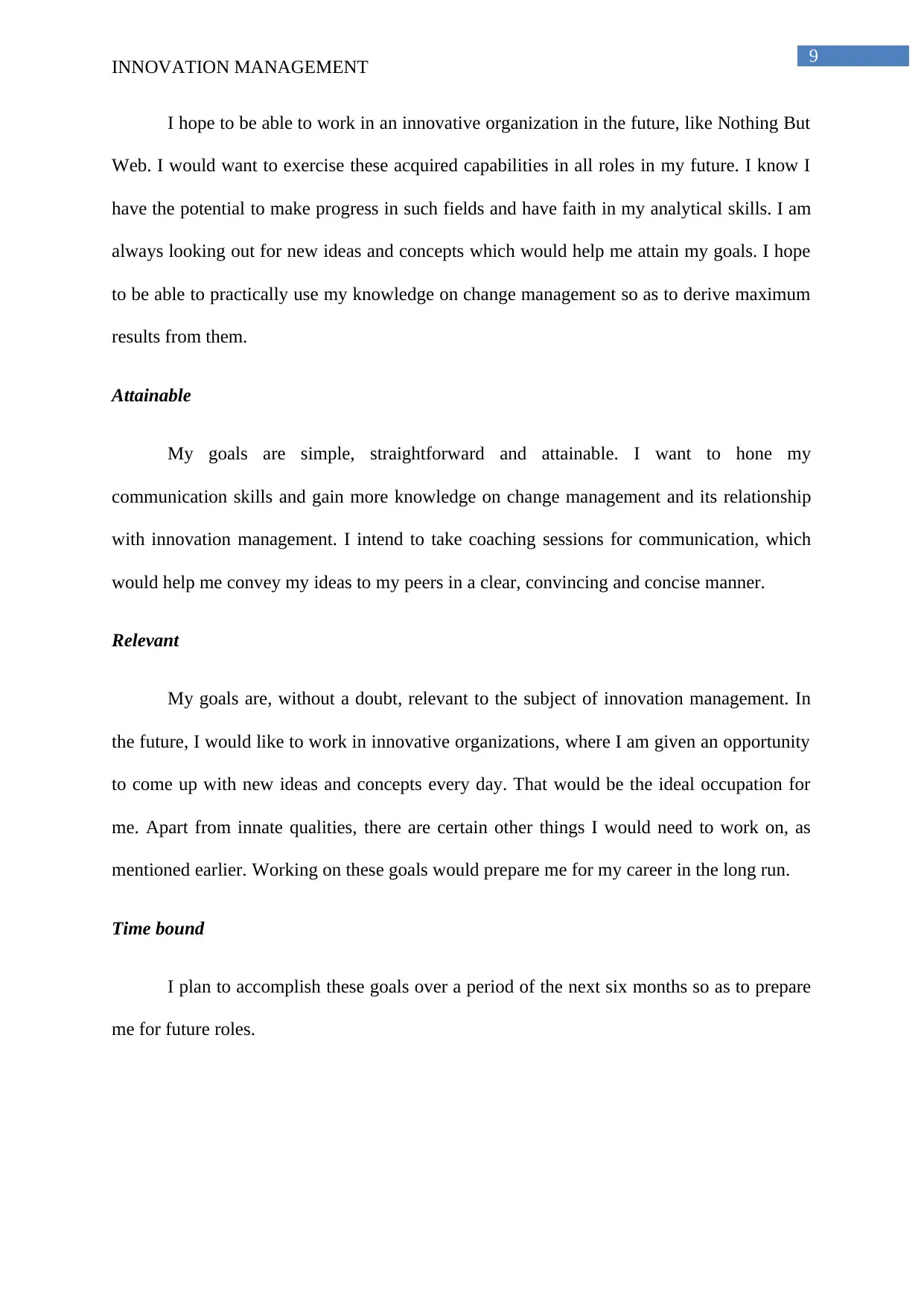
9
INNOVATION MANAGEMENT
I hope to be able to work in an innovative organization in the future, like Nothing But
Web. I would want to exercise these acquired capabilities in all roles in my future. I know I
have the potential to make progress in such fields and have faith in my analytical skills. I am
always looking out for new ideas and concepts which would help me attain my goals. I hope
to be able to practically use my knowledge on change management so as to derive maximum
results from them.
Attainable
My goals are simple, straightforward and attainable. I want to hone my
communication skills and gain more knowledge on change management and its relationship
with innovation management. I intend to take coaching sessions for communication, which
would help me convey my ideas to my peers in a clear, convincing and concise manner.
Relevant
My goals are, without a doubt, relevant to the subject of innovation management. In
the future, I would like to work in innovative organizations, where I am given an opportunity
to come up with new ideas and concepts every day. That would be the ideal occupation for
me. Apart from innate qualities, there are certain other things I would need to work on, as
mentioned earlier. Working on these goals would prepare me for my career in the long run.
Time bound
I plan to accomplish these goals over a period of the next six months so as to prepare
me for future roles.
INNOVATION MANAGEMENT
I hope to be able to work in an innovative organization in the future, like Nothing But
Web. I would want to exercise these acquired capabilities in all roles in my future. I know I
have the potential to make progress in such fields and have faith in my analytical skills. I am
always looking out for new ideas and concepts which would help me attain my goals. I hope
to be able to practically use my knowledge on change management so as to derive maximum
results from them.
Attainable
My goals are simple, straightforward and attainable. I want to hone my
communication skills and gain more knowledge on change management and its relationship
with innovation management. I intend to take coaching sessions for communication, which
would help me convey my ideas to my peers in a clear, convincing and concise manner.
Relevant
My goals are, without a doubt, relevant to the subject of innovation management. In
the future, I would like to work in innovative organizations, where I am given an opportunity
to come up with new ideas and concepts every day. That would be the ideal occupation for
me. Apart from innate qualities, there are certain other things I would need to work on, as
mentioned earlier. Working on these goals would prepare me for my career in the long run.
Time bound
I plan to accomplish these goals over a period of the next six months so as to prepare
me for future roles.
Secure Best Marks with AI Grader
Need help grading? Try our AI Grader for instant feedback on your assignments.
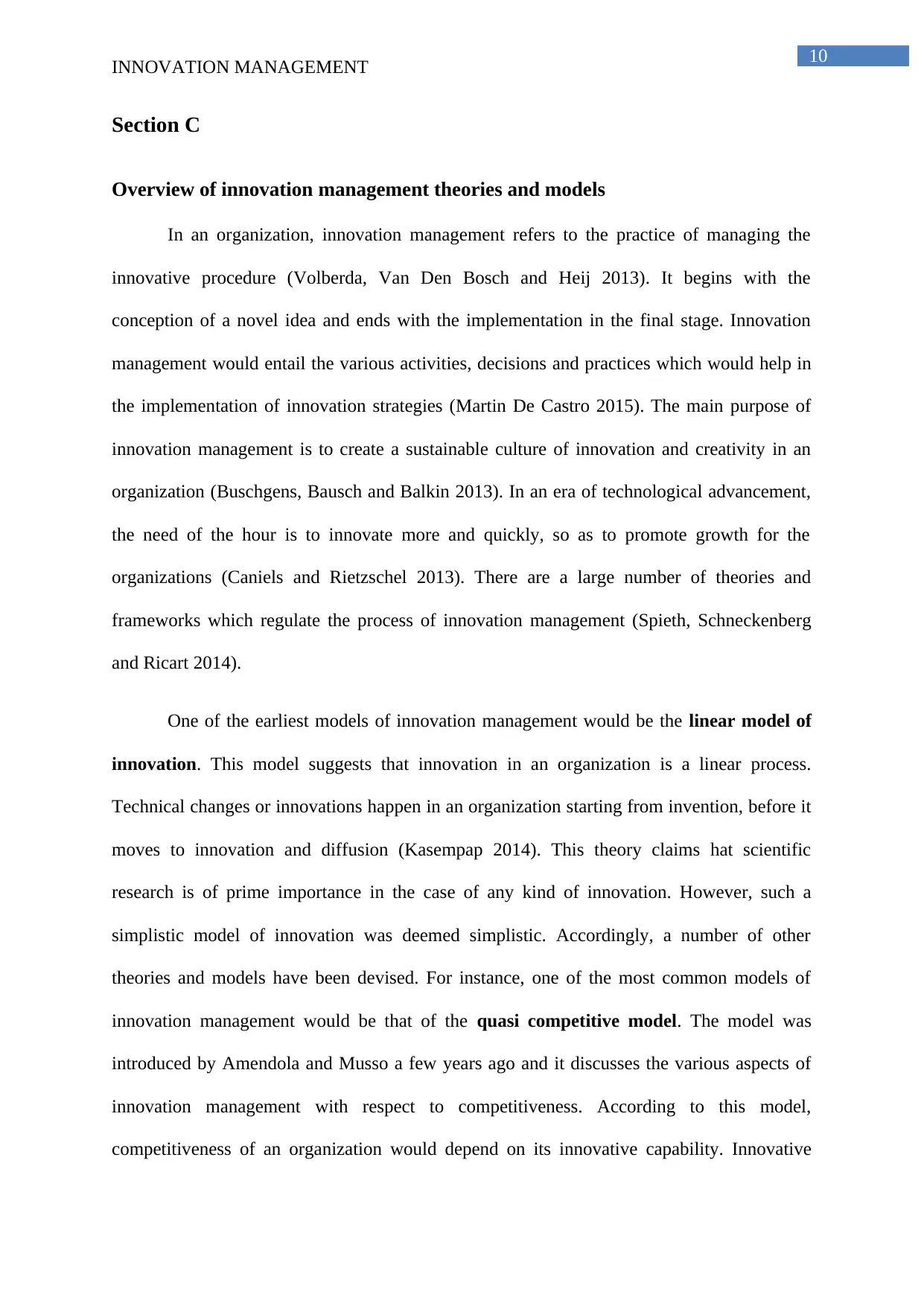
10
INNOVATION MANAGEMENT
Section C
Overview of innovation management theories and models
In an organization, innovation management refers to the practice of managing the
innovative procedure (Volberda, Van Den Bosch and Heij 2013). It begins with the
conception of a novel idea and ends with the implementation in the final stage. Innovation
management would entail the various activities, decisions and practices which would help in
the implementation of innovation strategies (Martin De Castro 2015). The main purpose of
innovation management is to create a sustainable culture of innovation and creativity in an
organization (Buschgens, Bausch and Balkin 2013). In an era of technological advancement,
the need of the hour is to innovate more and quickly, so as to promote growth for the
organizations (Caniels and Rietzschel 2013). There are a large number of theories and
frameworks which regulate the process of innovation management (Spieth, Schneckenberg
and Ricart 2014).
One of the earliest models of innovation management would be the linear model of
innovation. This model suggests that innovation in an organization is a linear process.
Technical changes or innovations happen in an organization starting from invention, before it
moves to innovation and diffusion (Kasempap 2014). This theory claims hat scientific
research is of prime importance in the case of any kind of innovation. However, such a
simplistic model of innovation was deemed simplistic. Accordingly, a number of other
theories and models have been devised. For instance, one of the most common models of
innovation management would be that of the quasi competitive model. The model was
introduced by Amendola and Musso a few years ago and it discusses the various aspects of
innovation management with respect to competitiveness. According to this model,
competitiveness of an organization would depend on its innovative capability. Innovative
INNOVATION MANAGEMENT
Section C
Overview of innovation management theories and models
In an organization, innovation management refers to the practice of managing the
innovative procedure (Volberda, Van Den Bosch and Heij 2013). It begins with the
conception of a novel idea and ends with the implementation in the final stage. Innovation
management would entail the various activities, decisions and practices which would help in
the implementation of innovation strategies (Martin De Castro 2015). The main purpose of
innovation management is to create a sustainable culture of innovation and creativity in an
organization (Buschgens, Bausch and Balkin 2013). In an era of technological advancement,
the need of the hour is to innovate more and quickly, so as to promote growth for the
organizations (Caniels and Rietzschel 2013). There are a large number of theories and
frameworks which regulate the process of innovation management (Spieth, Schneckenberg
and Ricart 2014).
One of the earliest models of innovation management would be the linear model of
innovation. This model suggests that innovation in an organization is a linear process.
Technical changes or innovations happen in an organization starting from invention, before it
moves to innovation and diffusion (Kasempap 2014). This theory claims hat scientific
research is of prime importance in the case of any kind of innovation. However, such a
simplistic model of innovation was deemed simplistic. Accordingly, a number of other
theories and models have been devised. For instance, one of the most common models of
innovation management would be that of the quasi competitive model. The model was
introduced by Amendola and Musso a few years ago and it discusses the various aspects of
innovation management with respect to competitiveness. According to this model,
competitiveness of an organization would depend on its innovative capability. Innovative
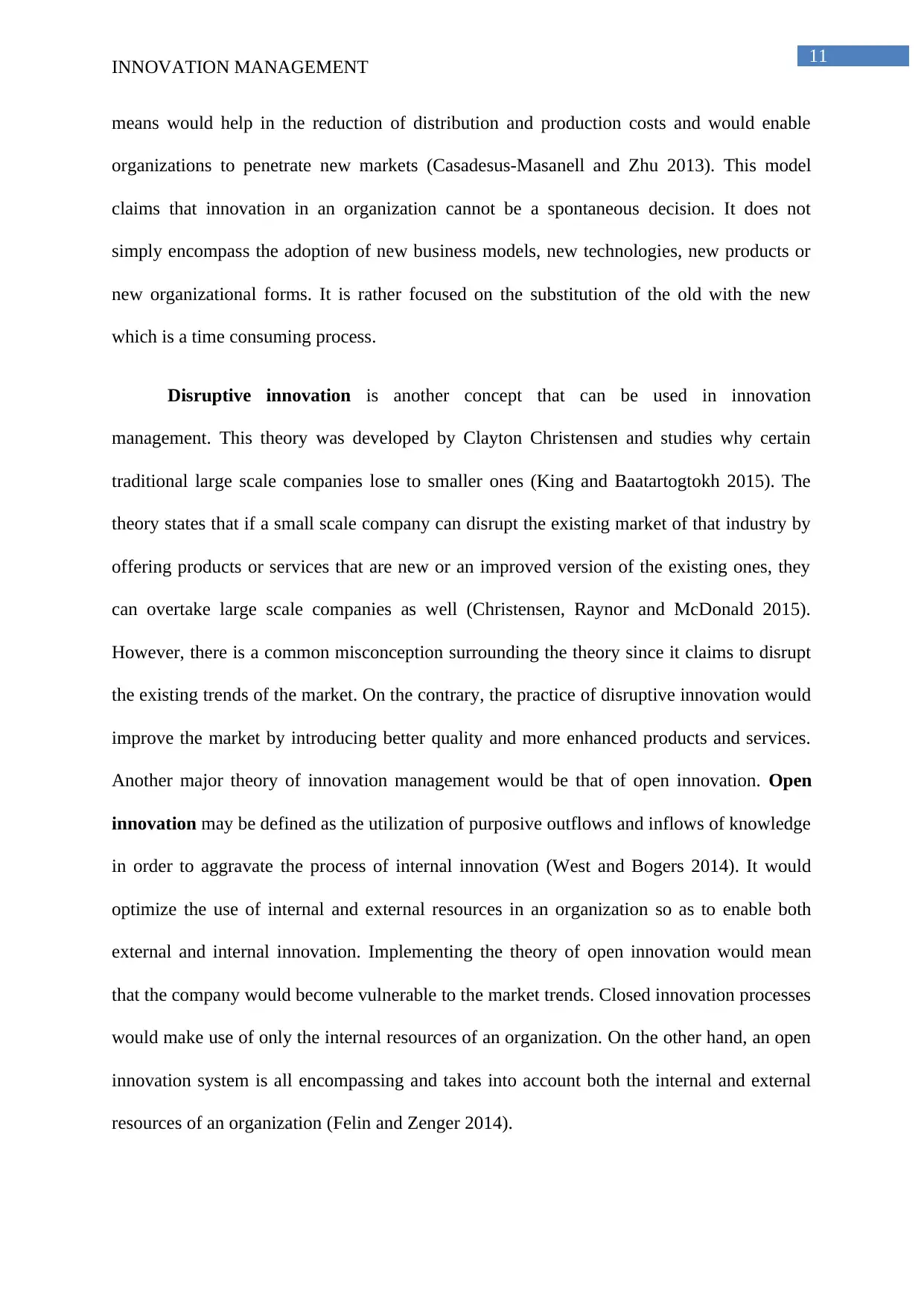
11
INNOVATION MANAGEMENT
means would help in the reduction of distribution and production costs and would enable
organizations to penetrate new markets (Casadesus‐Masanell and Zhu 2013). This model
claims that innovation in an organization cannot be a spontaneous decision. It does not
simply encompass the adoption of new business models, new technologies, new products or
new organizational forms. It is rather focused on the substitution of the old with the new
which is a time consuming process.
Disruptive innovation is another concept that can be used in innovation
management. This theory was developed by Clayton Christensen and studies why certain
traditional large scale companies lose to smaller ones (King and Baatartogtokh 2015). The
theory states that if a small scale company can disrupt the existing market of that industry by
offering products or services that are new or an improved version of the existing ones, they
can overtake large scale companies as well (Christensen, Raynor and McDonald 2015).
However, there is a common misconception surrounding the theory since it claims to disrupt
the existing trends of the market. On the contrary, the practice of disruptive innovation would
improve the market by introducing better quality and more enhanced products and services.
Another major theory of innovation management would be that of open innovation. Open
innovation may be defined as the utilization of purposive outflows and inflows of knowledge
in order to aggravate the process of internal innovation (West and Bogers 2014). It would
optimize the use of internal and external resources in an organization so as to enable both
external and internal innovation. Implementing the theory of open innovation would mean
that the company would become vulnerable to the market trends. Closed innovation processes
would make use of only the internal resources of an organization. On the other hand, an open
innovation system is all encompassing and takes into account both the internal and external
resources of an organization (Felin and Zenger 2014).
INNOVATION MANAGEMENT
means would help in the reduction of distribution and production costs and would enable
organizations to penetrate new markets (Casadesus‐Masanell and Zhu 2013). This model
claims that innovation in an organization cannot be a spontaneous decision. It does not
simply encompass the adoption of new business models, new technologies, new products or
new organizational forms. It is rather focused on the substitution of the old with the new
which is a time consuming process.
Disruptive innovation is another concept that can be used in innovation
management. This theory was developed by Clayton Christensen and studies why certain
traditional large scale companies lose to smaller ones (King and Baatartogtokh 2015). The
theory states that if a small scale company can disrupt the existing market of that industry by
offering products or services that are new or an improved version of the existing ones, they
can overtake large scale companies as well (Christensen, Raynor and McDonald 2015).
However, there is a common misconception surrounding the theory since it claims to disrupt
the existing trends of the market. On the contrary, the practice of disruptive innovation would
improve the market by introducing better quality and more enhanced products and services.
Another major theory of innovation management would be that of open innovation. Open
innovation may be defined as the utilization of purposive outflows and inflows of knowledge
in order to aggravate the process of internal innovation (West and Bogers 2014). It would
optimize the use of internal and external resources in an organization so as to enable both
external and internal innovation. Implementing the theory of open innovation would mean
that the company would become vulnerable to the market trends. Closed innovation processes
would make use of only the internal resources of an organization. On the other hand, an open
innovation system is all encompassing and takes into account both the internal and external
resources of an organization (Felin and Zenger 2014).

12
INNOVATION MANAGEMENT
Another important framework in corporate innovation and creativity is lean
innovation management. This framework would help companies work in more agile and
flexible ways as compared to traditional ways of project management (Khan et al. 2013). It
encourages the use of cost effective methods, allocation of small budgets, a strong feedback
system, building of MVPs or minimum viable products and prototypes and change
management if the need arises. This kind of innovation management would be most suited to
small scale companies or companies with limited resources. Such a lean approach to
innovation management would drastically reduce costs involved in the process and
simultaneously ensure the fulfillment of company objectives.
INNOVATION MANAGEMENT
Another important framework in corporate innovation and creativity is lean
innovation management. This framework would help companies work in more agile and
flexible ways as compared to traditional ways of project management (Khan et al. 2013). It
encourages the use of cost effective methods, allocation of small budgets, a strong feedback
system, building of MVPs or minimum viable products and prototypes and change
management if the need arises. This kind of innovation management would be most suited to
small scale companies or companies with limited resources. Such a lean approach to
innovation management would drastically reduce costs involved in the process and
simultaneously ensure the fulfillment of company objectives.
Paraphrase This Document
Need a fresh take? Get an instant paraphrase of this document with our AI Paraphraser
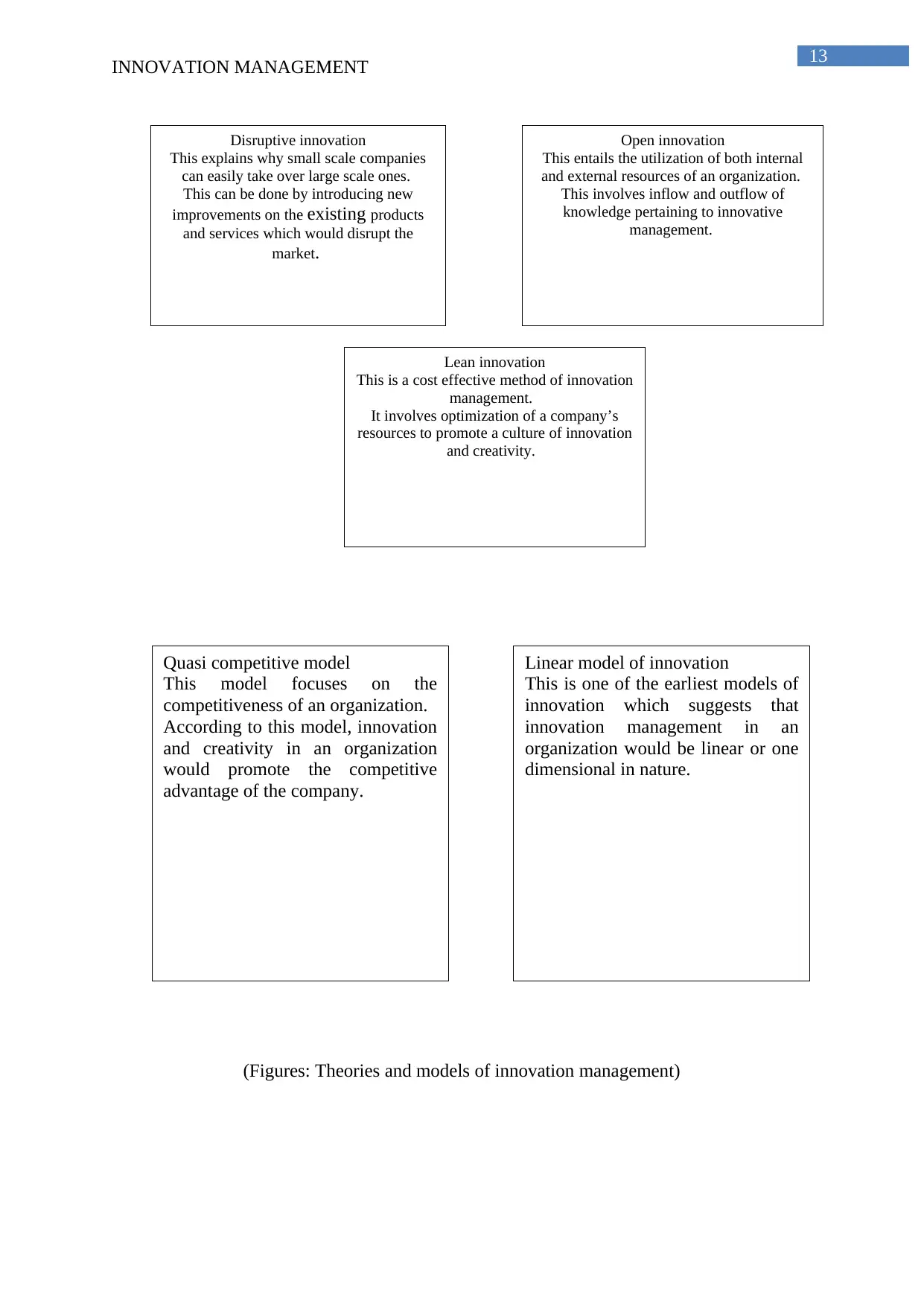
13
Disruptive innovation
This explains why small scale companies
can easily take over large scale ones.
This can be done by introducing new
improvements on the existing products
and services which would disrupt the
market.
Open innovation
This entails the utilization of both internal
and external resources of an organization.
This involves inflow and outflow of
knowledge pertaining to innovative
management.
Lean innovation
This is a cost effective method of innovation
management.
It involves optimization of a company’s
resources to promote a culture of innovation
and creativity.
Quasi competitive model
This model focuses on the
competitiveness of an organization.
According to this model, innovation
and creativity in an organization
would promote the competitive
advantage of the company.
Linear model of innovation
This is one of the earliest models of
innovation which suggests that
innovation management in an
organization would be linear or one
dimensional in nature.
INNOVATION MANAGEMENT
(Figures: Theories and models of innovation management)
Disruptive innovation
This explains why small scale companies
can easily take over large scale ones.
This can be done by introducing new
improvements on the existing products
and services which would disrupt the
market.
Open innovation
This entails the utilization of both internal
and external resources of an organization.
This involves inflow and outflow of
knowledge pertaining to innovative
management.
Lean innovation
This is a cost effective method of innovation
management.
It involves optimization of a company’s
resources to promote a culture of innovation
and creativity.
Quasi competitive model
This model focuses on the
competitiveness of an organization.
According to this model, innovation
and creativity in an organization
would promote the competitive
advantage of the company.
Linear model of innovation
This is one of the earliest models of
innovation which suggests that
innovation management in an
organization would be linear or one
dimensional in nature.
INNOVATION MANAGEMENT
(Figures: Theories and models of innovation management)
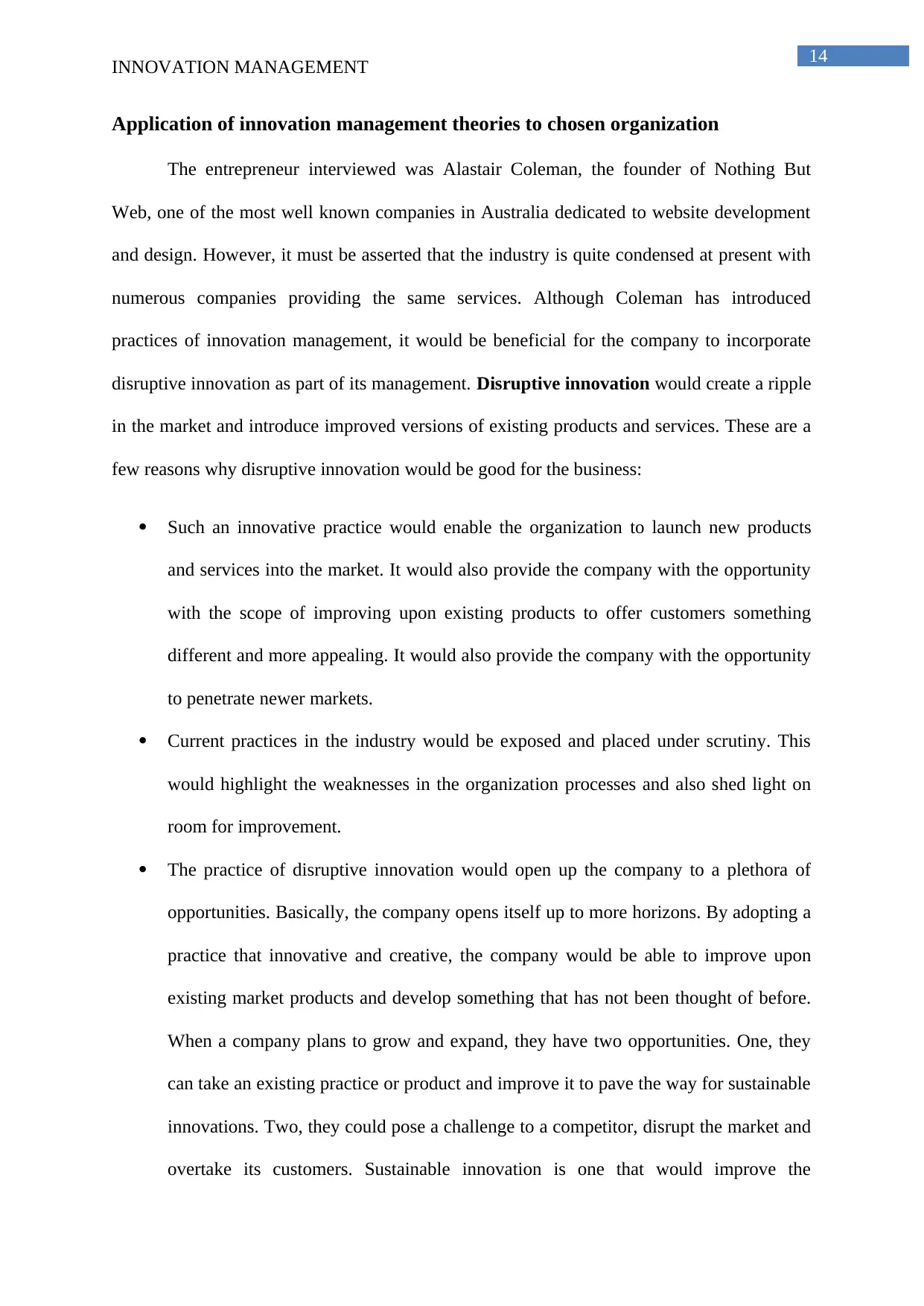
14
INNOVATION MANAGEMENT
Application of innovation management theories to chosen organization
The entrepreneur interviewed was Alastair Coleman, the founder of Nothing But
Web, one of the most well known companies in Australia dedicated to website development
and design. However, it must be asserted that the industry is quite condensed at present with
numerous companies providing the same services. Although Coleman has introduced
practices of innovation management, it would be beneficial for the company to incorporate
disruptive innovation as part of its management. Disruptive innovation would create a ripple
in the market and introduce improved versions of existing products and services. These are a
few reasons why disruptive innovation would be good for the business:
Such an innovative practice would enable the organization to launch new products
and services into the market. It would also provide the company with the opportunity
with the scope of improving upon existing products to offer customers something
different and more appealing. It would also provide the company with the opportunity
to penetrate newer markets.
Current practices in the industry would be exposed and placed under scrutiny. This
would highlight the weaknesses in the organization processes and also shed light on
room for improvement.
The practice of disruptive innovation would open up the company to a plethora of
opportunities. Basically, the company opens itself up to more horizons. By adopting a
practice that innovative and creative, the company would be able to improve upon
existing market products and develop something that has not been thought of before.
When a company plans to grow and expand, they have two opportunities. One, they
can take an existing practice or product and improve it to pave the way for sustainable
innovations. Two, they could pose a challenge to a competitor, disrupt the market and
overtake its customers. Sustainable innovation is one that would improve the
INNOVATION MANAGEMENT
Application of innovation management theories to chosen organization
The entrepreneur interviewed was Alastair Coleman, the founder of Nothing But
Web, one of the most well known companies in Australia dedicated to website development
and design. However, it must be asserted that the industry is quite condensed at present with
numerous companies providing the same services. Although Coleman has introduced
practices of innovation management, it would be beneficial for the company to incorporate
disruptive innovation as part of its management. Disruptive innovation would create a ripple
in the market and introduce improved versions of existing products and services. These are a
few reasons why disruptive innovation would be good for the business:
Such an innovative practice would enable the organization to launch new products
and services into the market. It would also provide the company with the opportunity
with the scope of improving upon existing products to offer customers something
different and more appealing. It would also provide the company with the opportunity
to penetrate newer markets.
Current practices in the industry would be exposed and placed under scrutiny. This
would highlight the weaknesses in the organization processes and also shed light on
room for improvement.
The practice of disruptive innovation would open up the company to a plethora of
opportunities. Basically, the company opens itself up to more horizons. By adopting a
practice that innovative and creative, the company would be able to improve upon
existing market products and develop something that has not been thought of before.
When a company plans to grow and expand, they have two opportunities. One, they
can take an existing practice or product and improve it to pave the way for sustainable
innovations. Two, they could pose a challenge to a competitor, disrupt the market and
overtake its customers. Sustainable innovation is one that would improve the
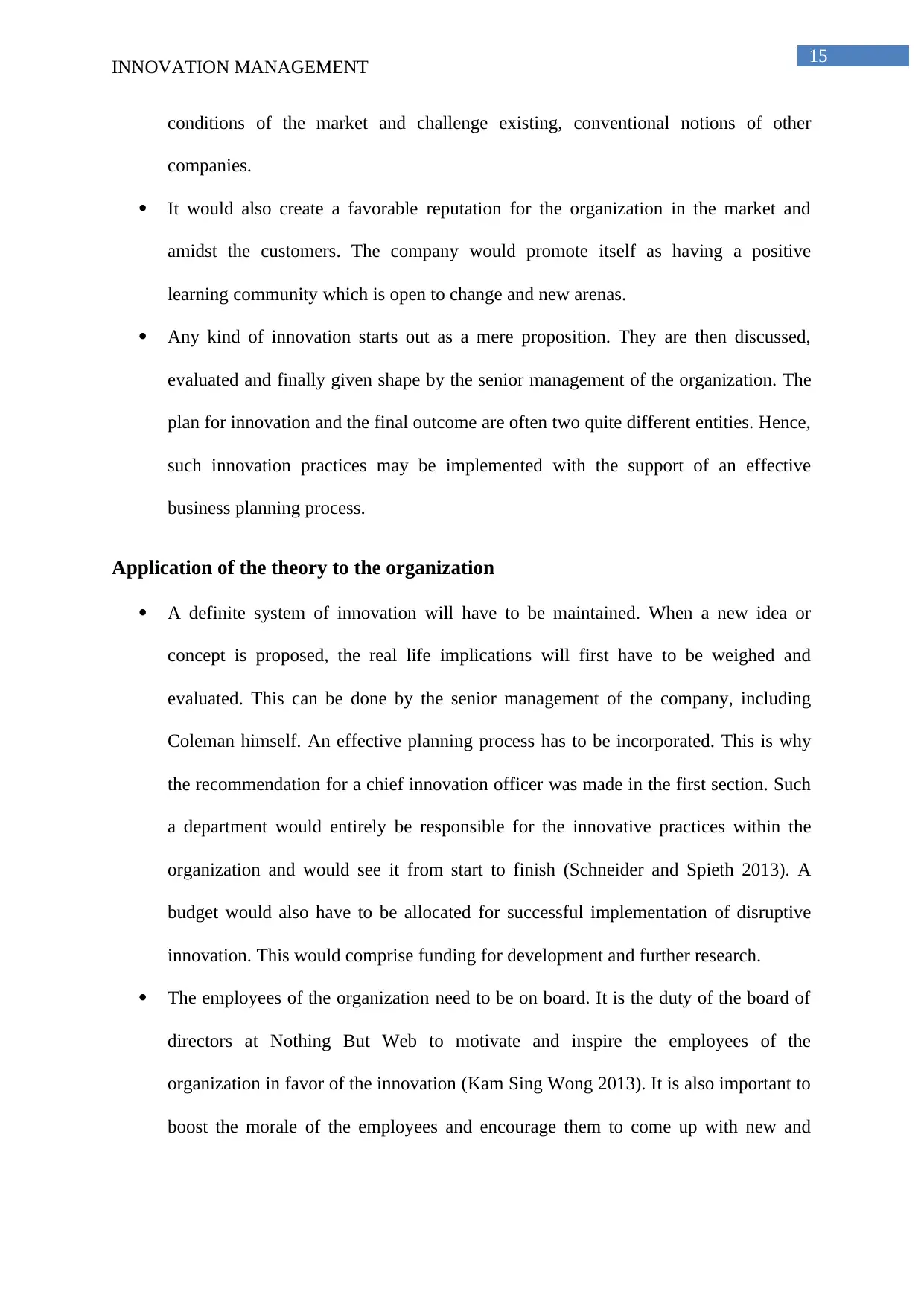
15
INNOVATION MANAGEMENT
conditions of the market and challenge existing, conventional notions of other
companies.
It would also create a favorable reputation for the organization in the market and
amidst the customers. The company would promote itself as having a positive
learning community which is open to change and new arenas.
Any kind of innovation starts out as a mere proposition. They are then discussed,
evaluated and finally given shape by the senior management of the organization. The
plan for innovation and the final outcome are often two quite different entities. Hence,
such innovation practices may be implemented with the support of an effective
business planning process.
Application of the theory to the organization
A definite system of innovation will have to be maintained. When a new idea or
concept is proposed, the real life implications will first have to be weighed and
evaluated. This can be done by the senior management of the company, including
Coleman himself. An effective planning process has to be incorporated. This is why
the recommendation for a chief innovation officer was made in the first section. Such
a department would entirely be responsible for the innovative practices within the
organization and would see it from start to finish (Schneider and Spieth 2013). A
budget would also have to be allocated for successful implementation of disruptive
innovation. This would comprise funding for development and further research.
The employees of the organization need to be on board. It is the duty of the board of
directors at Nothing But Web to motivate and inspire the employees of the
organization in favor of the innovation (Kam Sing Wong 2013). It is also important to
boost the morale of the employees and encourage them to come up with new and
INNOVATION MANAGEMENT
conditions of the market and challenge existing, conventional notions of other
companies.
It would also create a favorable reputation for the organization in the market and
amidst the customers. The company would promote itself as having a positive
learning community which is open to change and new arenas.
Any kind of innovation starts out as a mere proposition. They are then discussed,
evaluated and finally given shape by the senior management of the organization. The
plan for innovation and the final outcome are often two quite different entities. Hence,
such innovation practices may be implemented with the support of an effective
business planning process.
Application of the theory to the organization
A definite system of innovation will have to be maintained. When a new idea or
concept is proposed, the real life implications will first have to be weighed and
evaluated. This can be done by the senior management of the company, including
Coleman himself. An effective planning process has to be incorporated. This is why
the recommendation for a chief innovation officer was made in the first section. Such
a department would entirely be responsible for the innovative practices within the
organization and would see it from start to finish (Schneider and Spieth 2013). A
budget would also have to be allocated for successful implementation of disruptive
innovation. This would comprise funding for development and further research.
The employees of the organization need to be on board. It is the duty of the board of
directors at Nothing But Web to motivate and inspire the employees of the
organization in favor of the innovation (Kam Sing Wong 2013). It is also important to
boost the morale of the employees and encourage them to come up with new and
Secure Best Marks with AI Grader
Need help grading? Try our AI Grader for instant feedback on your assignments.

16
INNOVATION MANAGEMENT
creative ideas which would promote the quality of products and services offered by
the company.
Change management is another important aspect of such an approach. Implementing
any kind of innovation within the organization would require some sort of change,
which is usually met with resistance. It is the duty of the organization leaders to lead
the change and guide the organization in this aspect.
Teams would have to be formed within the organization for this specific purpose. The
team members would be entrusted with the responsibility of creation, strategizing,
evaluation and execution of innovative projects. Clear guidelines and directions
would have to be presented to these teams for successful implementation (Laursen
and Foss 2014).
Training programs would have to be incorporated. Such training programs would train
the concerned parties in entrepreneurism, change management and disruptive
thinking. Such training programs would ensure that each member of the organization
is on board. Moreover, it would encourage all members of the organization to think
out of the box and come up with innovative and novel ideas which would benefit the
organization in the long run.
Conclusion:
To conclude, it can be said that innovative management or management of creativity
and innovation in an organization is of utmost importance. It would include management of
every practice and approach associated with innovation and corporate creativity. As part of
the report, I was asked to interview an entrepreneur who is reputed for coming up with new,
innovative practices. I interviewed Alastair Coleman, who helped me gain better
understanding of the concepts of innovation management. It became clear to me that
INNOVATION MANAGEMENT
creative ideas which would promote the quality of products and services offered by
the company.
Change management is another important aspect of such an approach. Implementing
any kind of innovation within the organization would require some sort of change,
which is usually met with resistance. It is the duty of the organization leaders to lead
the change and guide the organization in this aspect.
Teams would have to be formed within the organization for this specific purpose. The
team members would be entrusted with the responsibility of creation, strategizing,
evaluation and execution of innovative projects. Clear guidelines and directions
would have to be presented to these teams for successful implementation (Laursen
and Foss 2014).
Training programs would have to be incorporated. Such training programs would train
the concerned parties in entrepreneurism, change management and disruptive
thinking. Such training programs would ensure that each member of the organization
is on board. Moreover, it would encourage all members of the organization to think
out of the box and come up with innovative and novel ideas which would benefit the
organization in the long run.
Conclusion:
To conclude, it can be said that innovative management or management of creativity
and innovation in an organization is of utmost importance. It would include management of
every practice and approach associated with innovation and corporate creativity. As part of
the report, I was asked to interview an entrepreneur who is reputed for coming up with new,
innovative practices. I interviewed Alastair Coleman, who helped me gain better
understanding of the concepts of innovation management. It became clear to me that
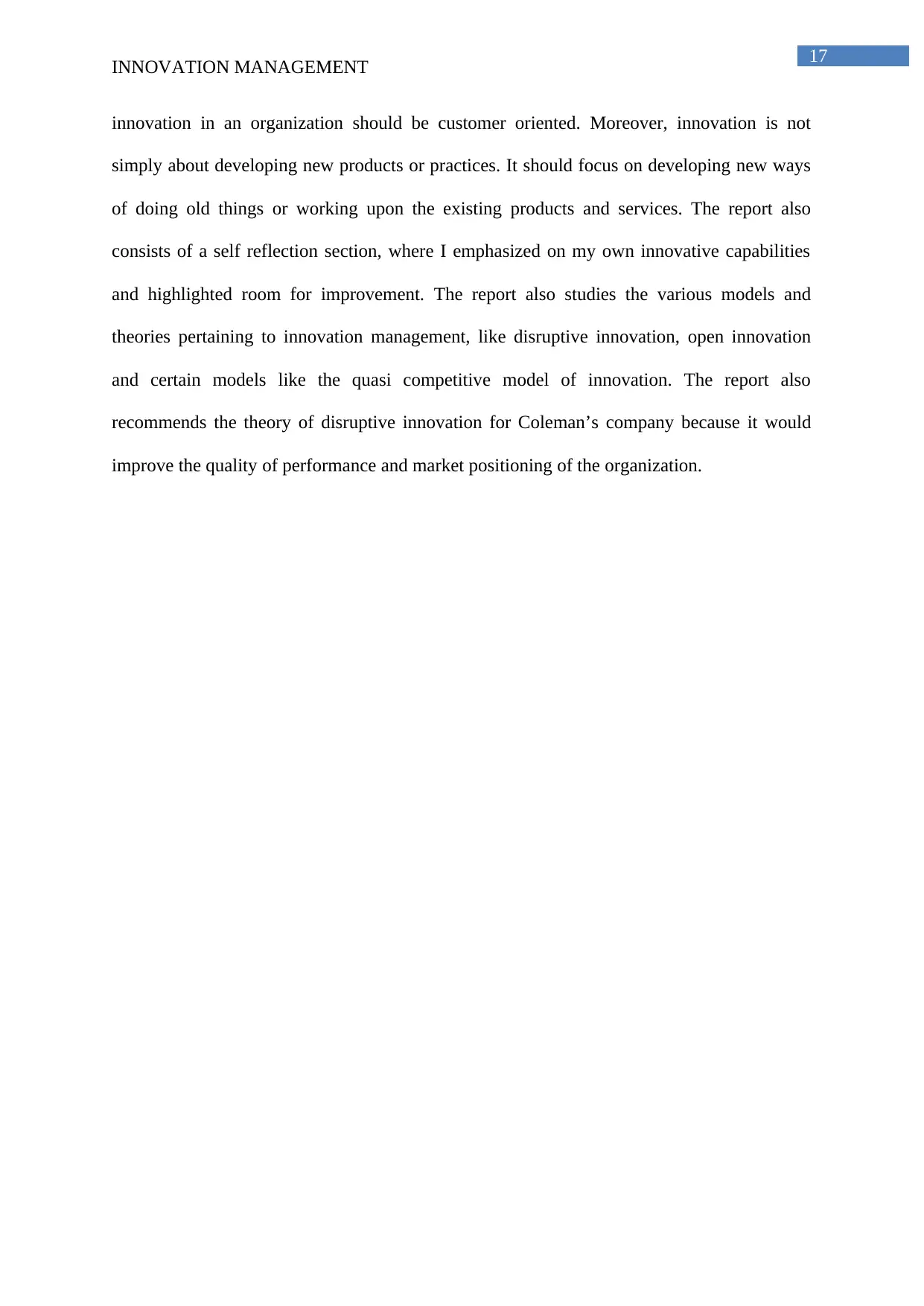
17
INNOVATION MANAGEMENT
innovation in an organization should be customer oriented. Moreover, innovation is not
simply about developing new products or practices. It should focus on developing new ways
of doing old things or working upon the existing products and services. The report also
consists of a self reflection section, where I emphasized on my own innovative capabilities
and highlighted room for improvement. The report also studies the various models and
theories pertaining to innovation management, like disruptive innovation, open innovation
and certain models like the quasi competitive model of innovation. The report also
recommends the theory of disruptive innovation for Coleman’s company because it would
improve the quality of performance and market positioning of the organization.
INNOVATION MANAGEMENT
innovation in an organization should be customer oriented. Moreover, innovation is not
simply about developing new products or practices. It should focus on developing new ways
of doing old things or working upon the existing products and services. The report also
consists of a self reflection section, where I emphasized on my own innovative capabilities
and highlighted room for improvement. The report also studies the various models and
theories pertaining to innovation management, like disruptive innovation, open innovation
and certain models like the quasi competitive model of innovation. The report also
recommends the theory of disruptive innovation for Coleman’s company because it would
improve the quality of performance and market positioning of the organization.
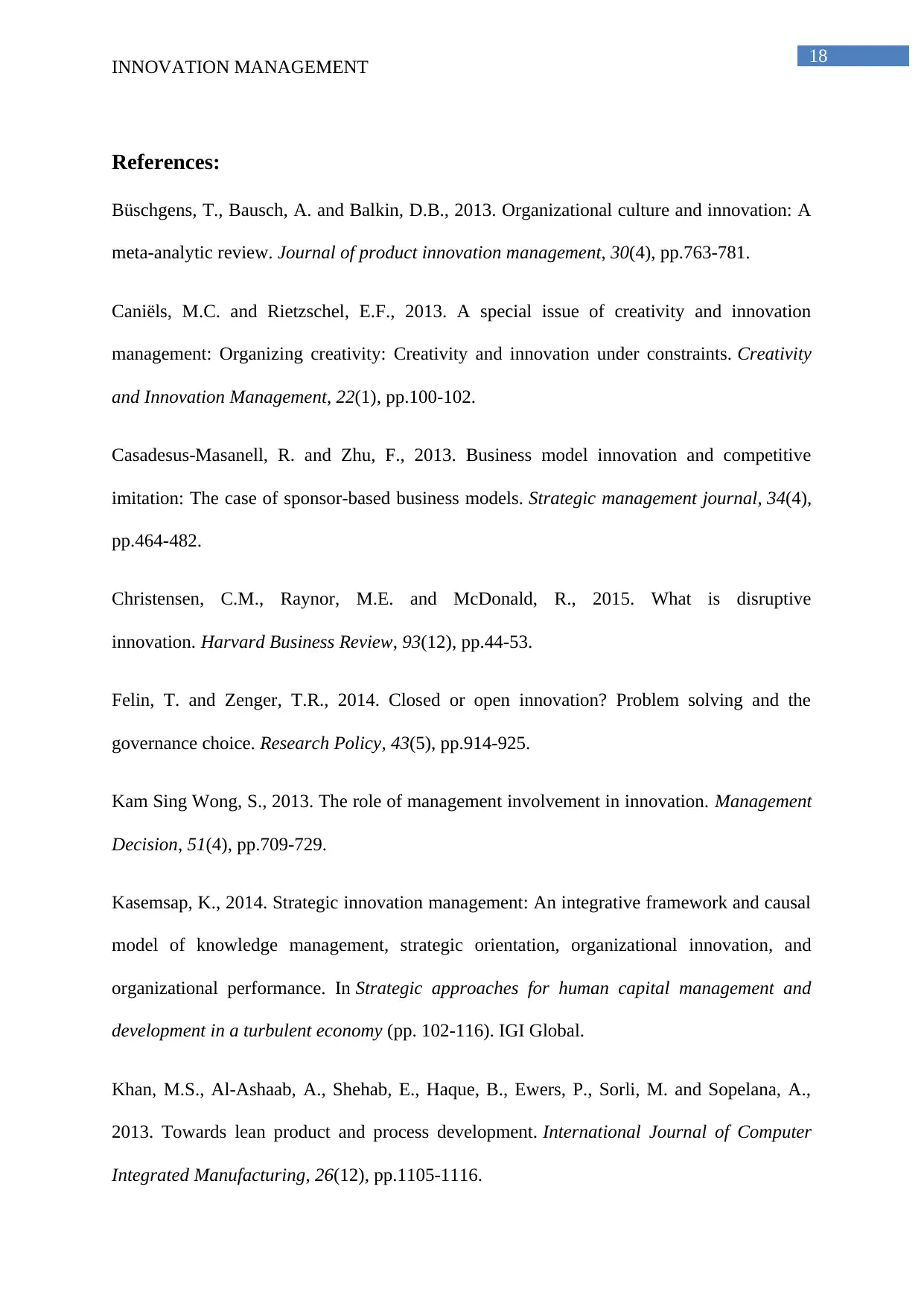
18
INNOVATION MANAGEMENT
References:
Büschgens, T., Bausch, A. and Balkin, D.B., 2013. Organizational culture and innovation: A
meta‐analytic review. Journal of product innovation management, 30(4), pp.763-781.
Caniëls, M.C. and Rietzschel, E.F., 2013. A special issue of creativity and innovation
management: Organizing creativity: Creativity and innovation under constraints. Creativity
and Innovation Management, 22(1), pp.100-102.
Casadesus‐Masanell, R. and Zhu, F., 2013. Business model innovation and competitive
imitation: The case of sponsor‐based business models. Strategic management journal, 34(4),
pp.464-482.
Christensen, C.M., Raynor, M.E. and McDonald, R., 2015. What is disruptive
innovation. Harvard Business Review, 93(12), pp.44-53.
Felin, T. and Zenger, T.R., 2014. Closed or open innovation? Problem solving and the
governance choice. Research Policy, 43(5), pp.914-925.
Kam Sing Wong, S., 2013. The role of management involvement in innovation. Management
Decision, 51(4), pp.709-729.
Kasemsap, K., 2014. Strategic innovation management: An integrative framework and causal
model of knowledge management, strategic orientation, organizational innovation, and
organizational performance. In Strategic approaches for human capital management and
development in a turbulent economy (pp. 102-116). IGI Global.
Khan, M.S., Al-Ashaab, A., Shehab, E., Haque, B., Ewers, P., Sorli, M. and Sopelana, A.,
2013. Towards lean product and process development. International Journal of Computer
Integrated Manufacturing, 26(12), pp.1105-1116.
INNOVATION MANAGEMENT
References:
Büschgens, T., Bausch, A. and Balkin, D.B., 2013. Organizational culture and innovation: A
meta‐analytic review. Journal of product innovation management, 30(4), pp.763-781.
Caniëls, M.C. and Rietzschel, E.F., 2013. A special issue of creativity and innovation
management: Organizing creativity: Creativity and innovation under constraints. Creativity
and Innovation Management, 22(1), pp.100-102.
Casadesus‐Masanell, R. and Zhu, F., 2013. Business model innovation and competitive
imitation: The case of sponsor‐based business models. Strategic management journal, 34(4),
pp.464-482.
Christensen, C.M., Raynor, M.E. and McDonald, R., 2015. What is disruptive
innovation. Harvard Business Review, 93(12), pp.44-53.
Felin, T. and Zenger, T.R., 2014. Closed or open innovation? Problem solving and the
governance choice. Research Policy, 43(5), pp.914-925.
Kam Sing Wong, S., 2013. The role of management involvement in innovation. Management
Decision, 51(4), pp.709-729.
Kasemsap, K., 2014. Strategic innovation management: An integrative framework and causal
model of knowledge management, strategic orientation, organizational innovation, and
organizational performance. In Strategic approaches for human capital management and
development in a turbulent economy (pp. 102-116). IGI Global.
Khan, M.S., Al-Ashaab, A., Shehab, E., Haque, B., Ewers, P., Sorli, M. and Sopelana, A.,
2013. Towards lean product and process development. International Journal of Computer
Integrated Manufacturing, 26(12), pp.1105-1116.
Paraphrase This Document
Need a fresh take? Get an instant paraphrase of this document with our AI Paraphraser

19
INNOVATION MANAGEMENT
King, A.A. and Baatartogtokh, B., 2015. How useful is the theory of disruptive
innovation?. MIT Sloan Management Review, 57(1), p.77.
Laursen, K. and Foss, N.J., 2014. Human resource management practices and
innovation. Handbook of innovation management, pp.505-530.
Martín-de Castro, G., 2015. Knowledge management and innovation in knowledge-based and
high-tech industrial markets: The role of openness and absorptive capacity. Industrial
Marketing Management, 47, pp.143-146.
Schneider, S. and Spieth, P., 2013. Business model innovation: Towards an integrated future
research agenda. International Journal of Innovation Management, 17(01), p.1340001.
Spieth, P., Schneckenberg, D. and Ricart, J.E., 2014. Business model innovation–state of the
art and future challenges for the field. R&d Management, 44(3), pp.237-247.
Volberda, H.W., Van Den Bosch, F.A. and Heij, C.V., 2013. Management innovation:
Management as fertile ground for innovation. European Management Review, 10(1), pp.1-15.
West, J. and Bogers, M., 2014. Leveraging external sources of innovation: a review of
research on open innovation. Journal of Product Innovation Management, 31(4), pp.814-831.
INNOVATION MANAGEMENT
King, A.A. and Baatartogtokh, B., 2015. How useful is the theory of disruptive
innovation?. MIT Sloan Management Review, 57(1), p.77.
Laursen, K. and Foss, N.J., 2014. Human resource management practices and
innovation. Handbook of innovation management, pp.505-530.
Martín-de Castro, G., 2015. Knowledge management and innovation in knowledge-based and
high-tech industrial markets: The role of openness and absorptive capacity. Industrial
Marketing Management, 47, pp.143-146.
Schneider, S. and Spieth, P., 2013. Business model innovation: Towards an integrated future
research agenda. International Journal of Innovation Management, 17(01), p.1340001.
Spieth, P., Schneckenberg, D. and Ricart, J.E., 2014. Business model innovation–state of the
art and future challenges for the field. R&d Management, 44(3), pp.237-247.
Volberda, H.W., Van Den Bosch, F.A. and Heij, C.V., 2013. Management innovation:
Management as fertile ground for innovation. European Management Review, 10(1), pp.1-15.
West, J. and Bogers, M., 2014. Leveraging external sources of innovation: a review of
research on open innovation. Journal of Product Innovation Management, 31(4), pp.814-831.
1 out of 20
Related Documents
Your All-in-One AI-Powered Toolkit for Academic Success.
+13062052269
info@desklib.com
Available 24*7 on WhatsApp / Email
![[object Object]](/_next/static/media/star-bottom.7253800d.svg)
Unlock your academic potential
© 2024 | Zucol Services PVT LTD | All rights reserved.




